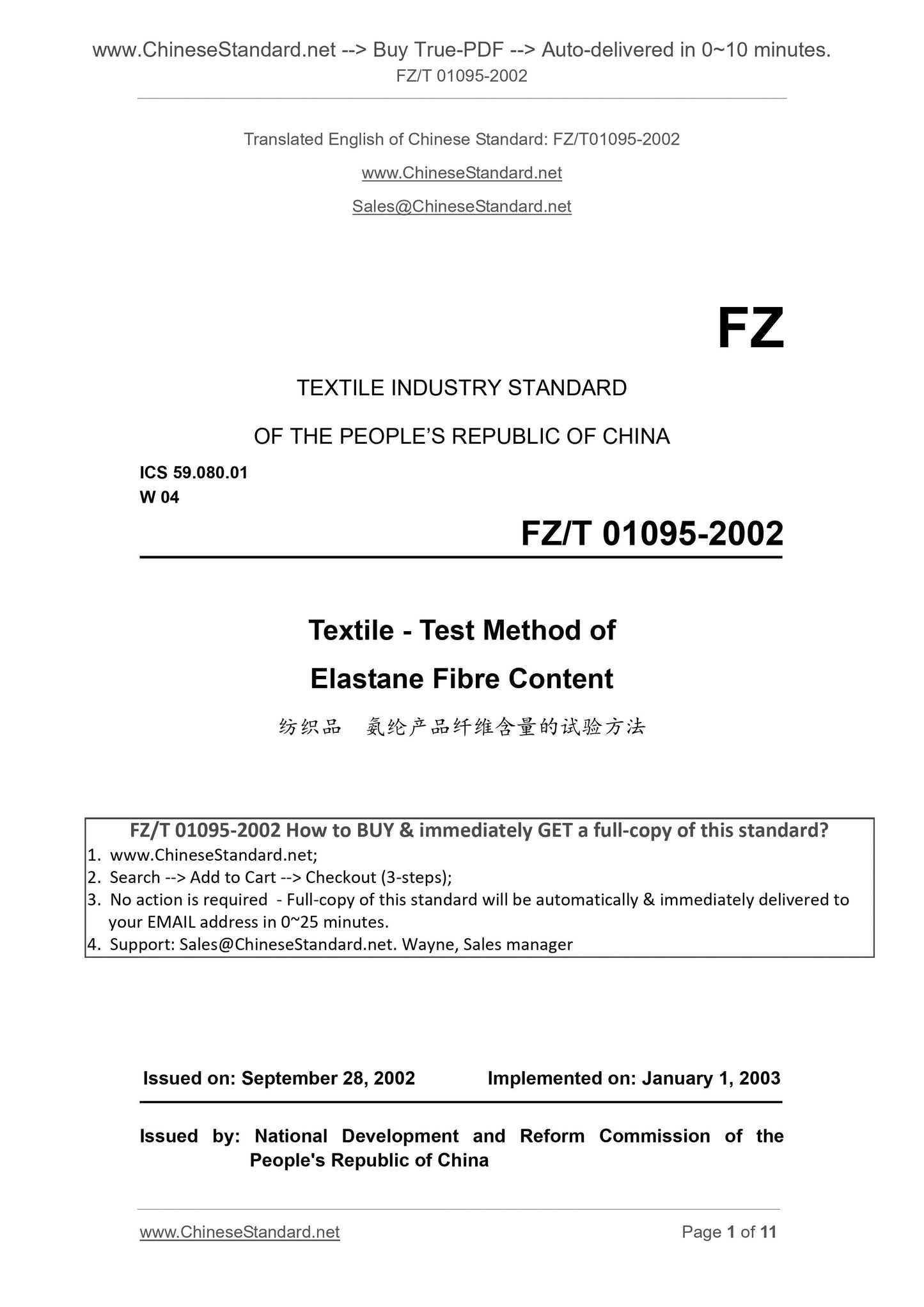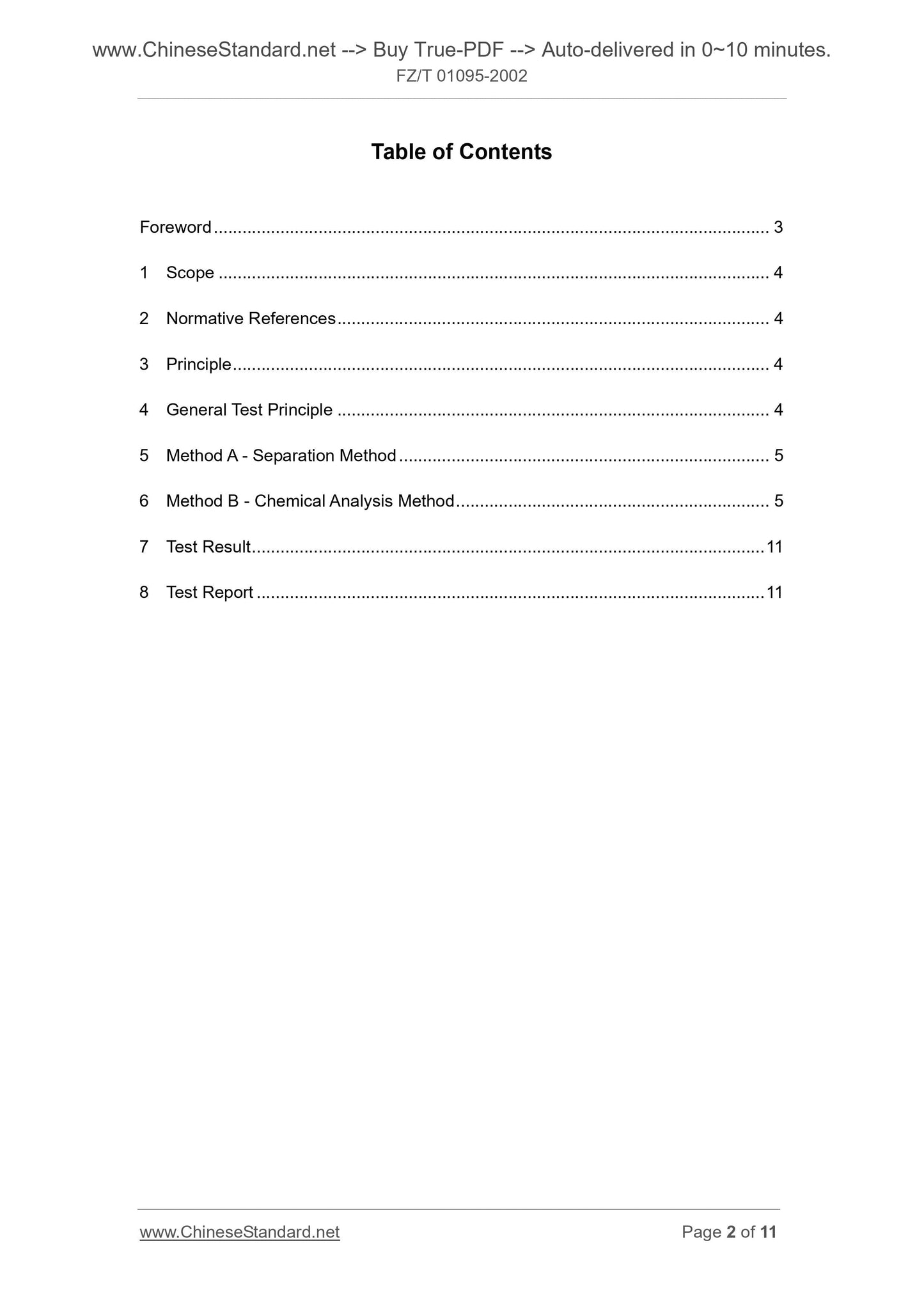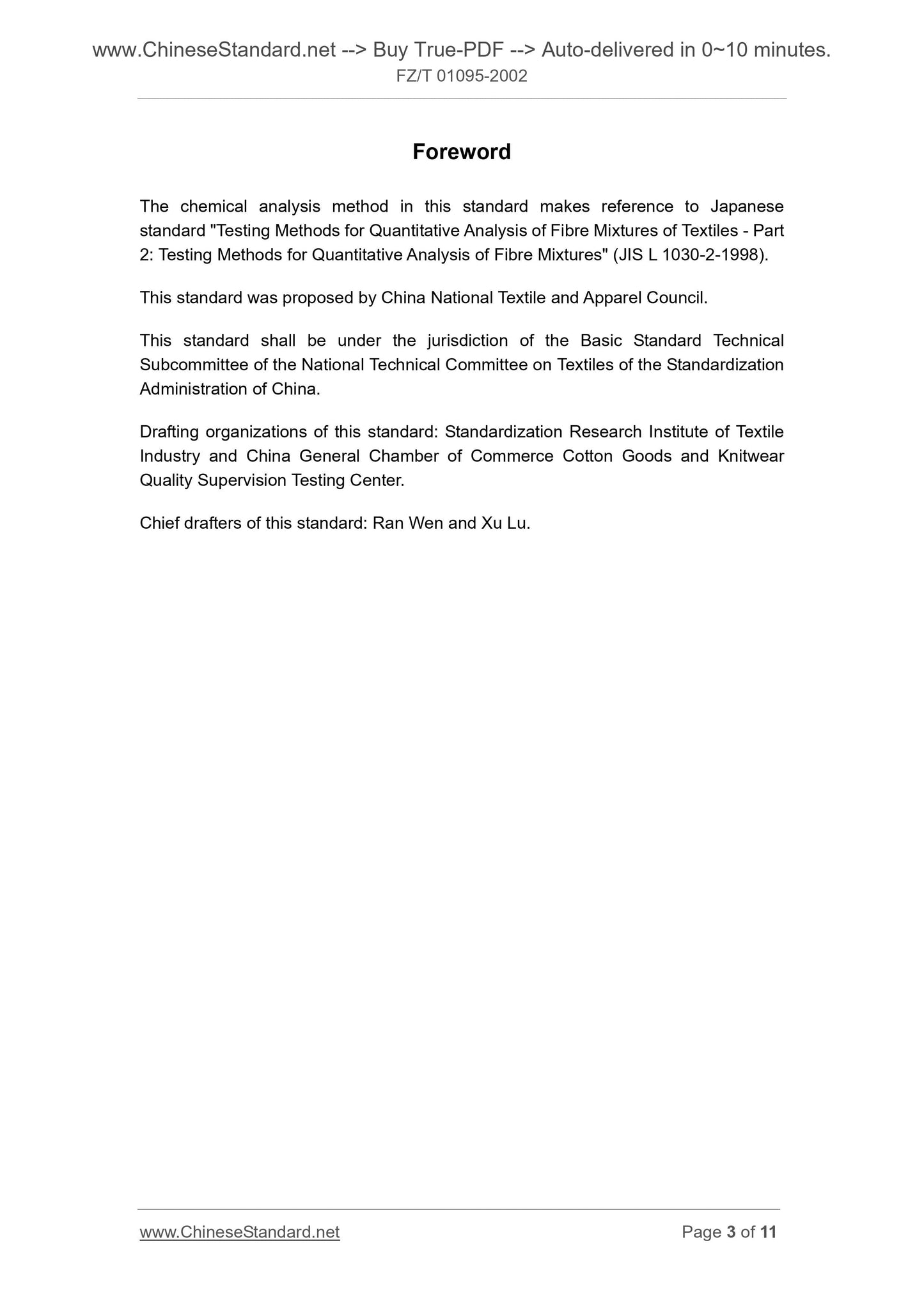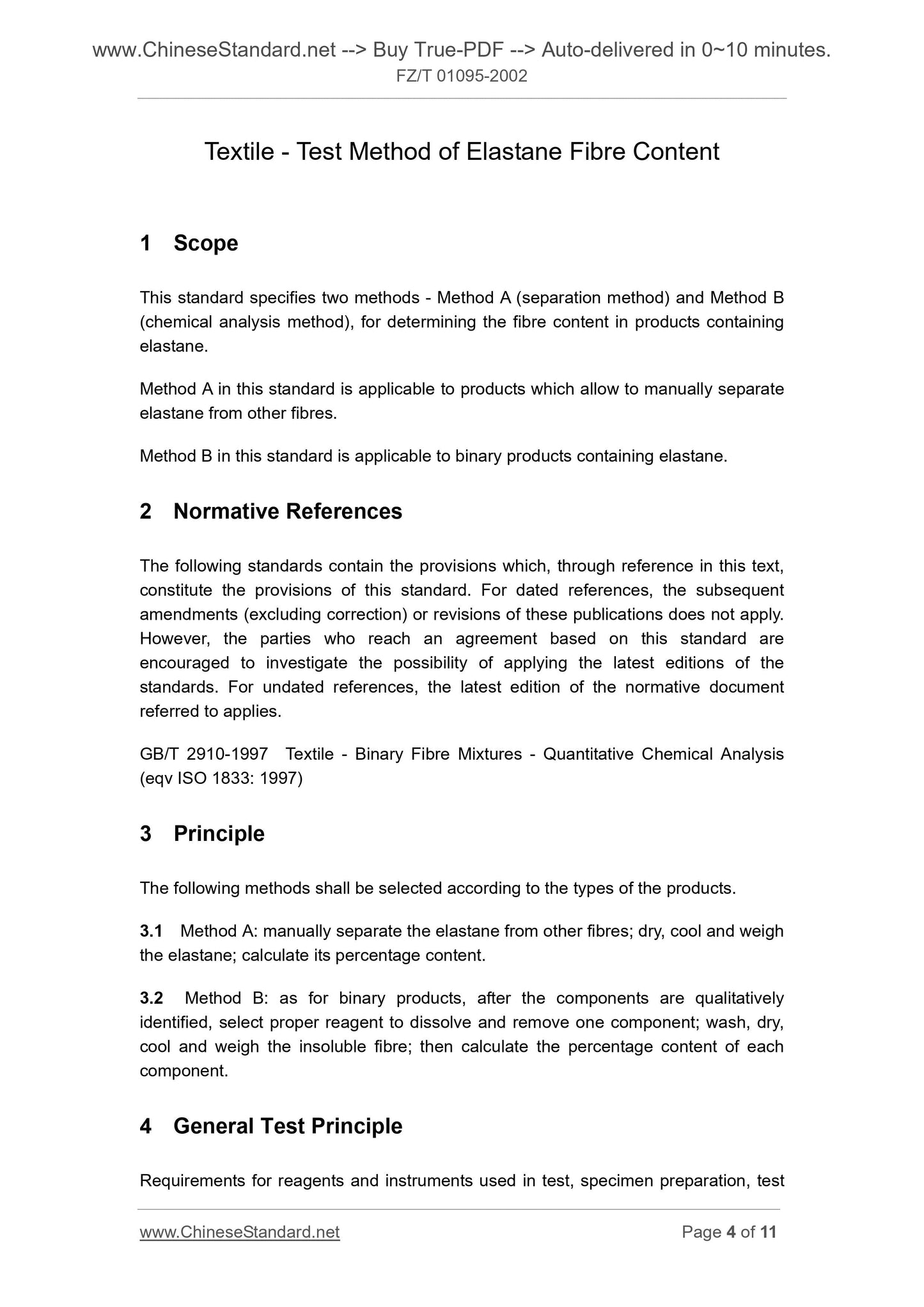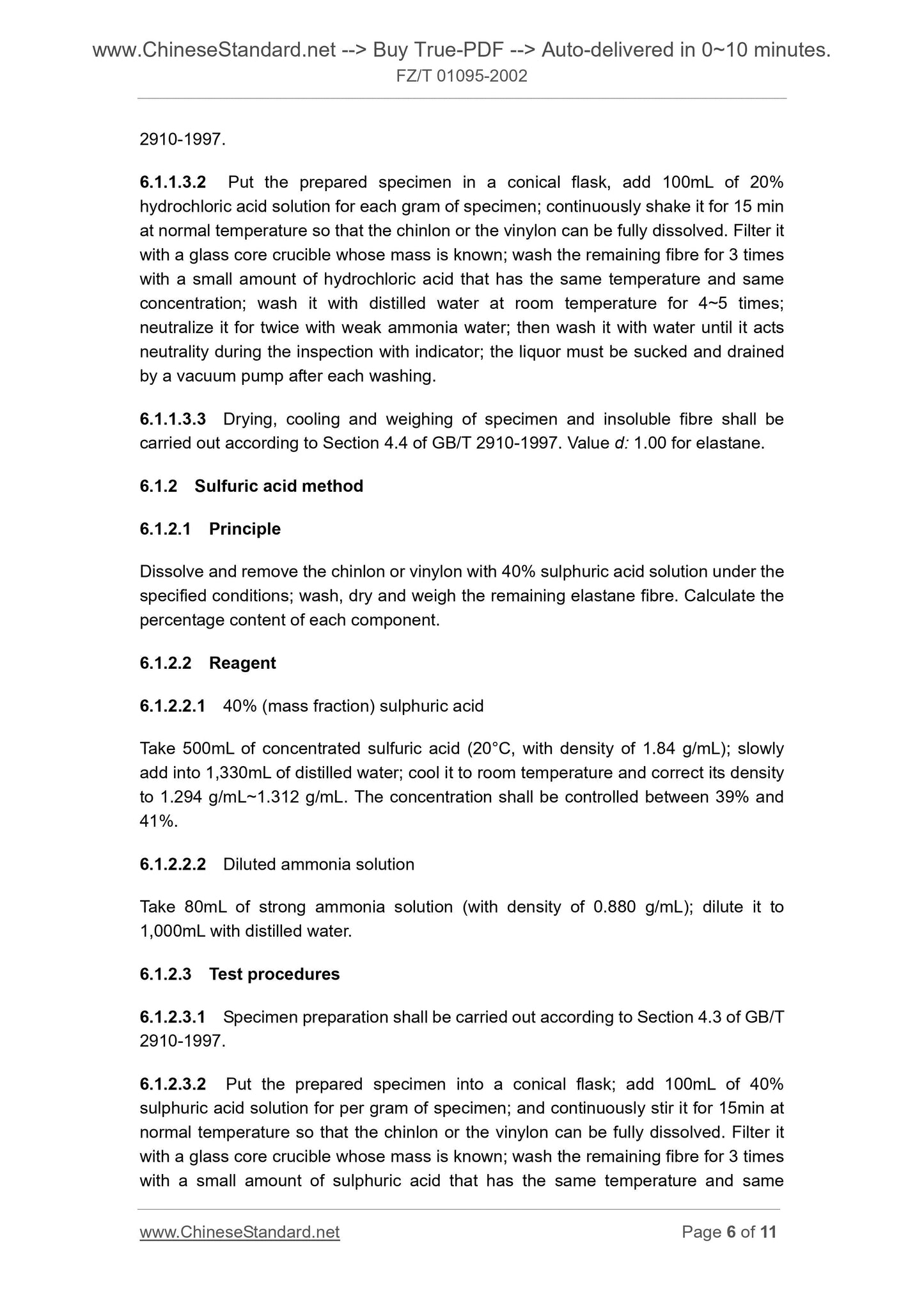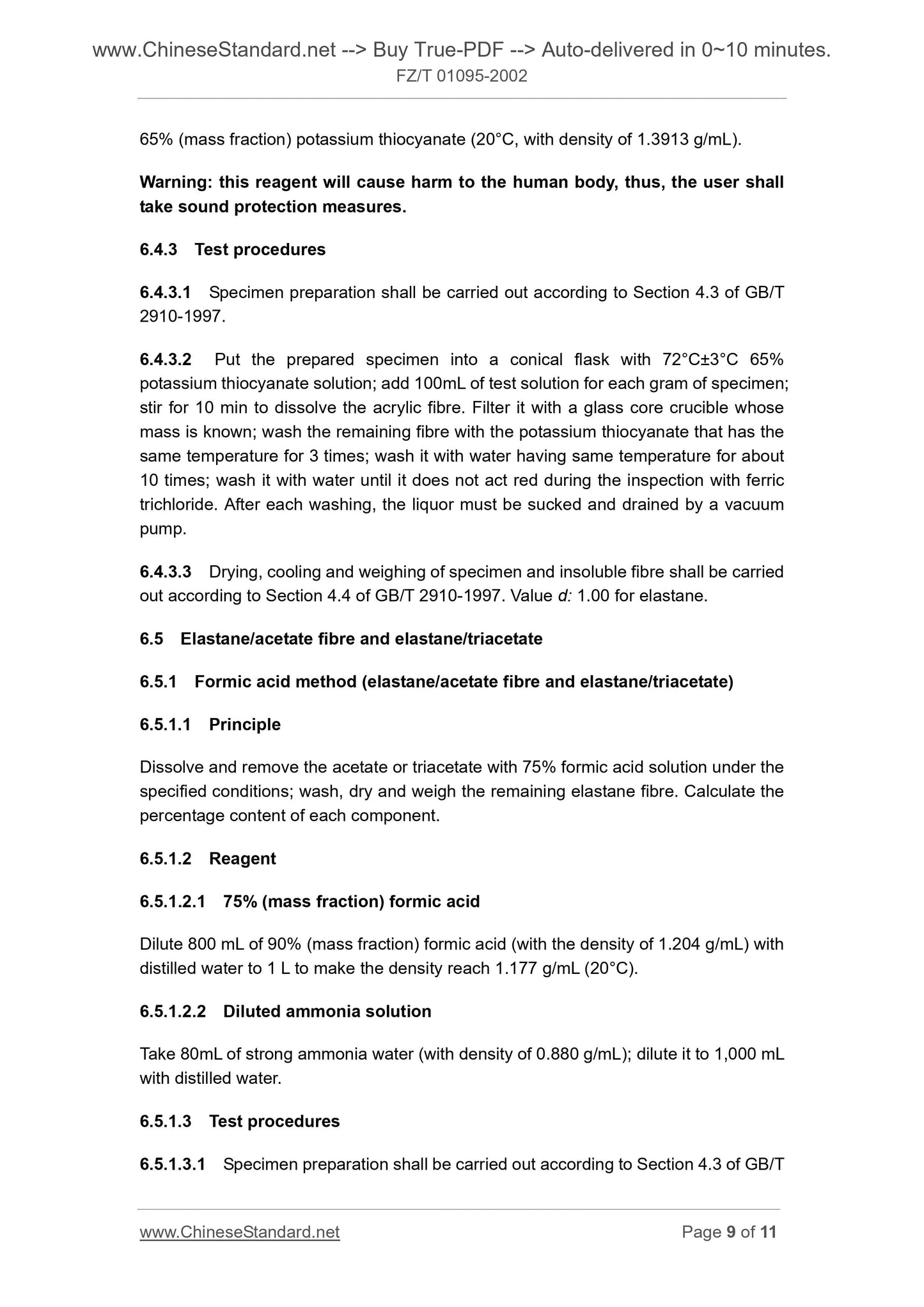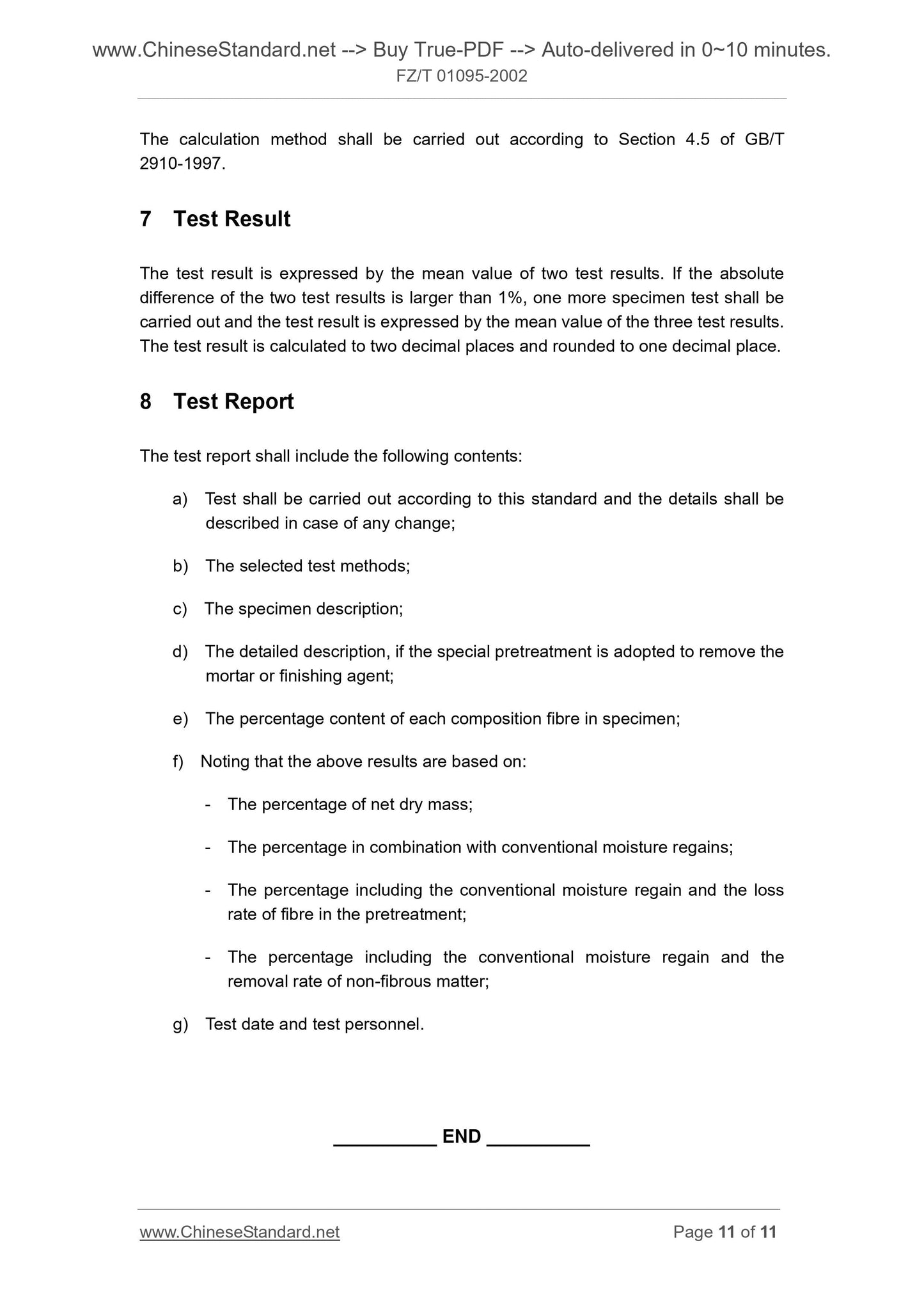1
/
의
7
PayPal, credit cards. Download editable-PDF and invoice in 1 second!
FZ/T 01095-2002 English PDF (FZT01095-2002)
FZ/T 01095-2002 English PDF (FZT01095-2002)
정가
$70.00 USD
정가
할인가
$70.00 USD
단가
/
단위
배송료는 결제 시 계산됩니다.
픽업 사용 가능 여부를 로드할 수 없습니다.
Delivery: 3 seconds. Download true-PDF + Invoice.
Get QUOTATION in 1-minute: Click FZ/T 01095-2002
Historical versions: FZ/T 01095-2002
Preview True-PDF (Reload/Scroll if blank)
FZ/T 01095-2002: Textile - Test method of elastane fibre content
FZ/T 01095-2002
FZ
TEXTILE INDUSTRY STANDARD
OF THE PEOPLE’S REPUBLIC OF CHINA
ICS 59.080.01
W 04
Textile - Test Method of
Elastane Fibre Content
ISSUED ON. SEPTEMBER 28, 2002
IMPLEMENTED ON. JANUARY 1, 2003
Issued by. National Development and Reform Commission of the
People's Republic of China
Table of Contents
Foreword ... 3
1 Scope ... 4
2 Normative References ... 4
3 Principle ... 4
4 General Test Principle ... 4
5 Method A - Separation Method ... 5
6 Method B - Chemical Analysis Method ... 5
7 Test Result ... 11
8 Test Report ... 11
Foreword
The chemical analysis method in this standard makes reference to Japanese
standard "Testing Methods for Quantitative Analysis of Fibre Mixtures of Textiles - Part
2. Testing Methods for Quantitative Analysis of Fibre Mixtures" (JIS L 1030-2-1998).
This standard was proposed by China National Textile and Apparel Council.
This standard shall be under the jurisdiction of the Basic Standard Technical
Subcommittee of the National Technical Committee on Textiles of the Standardization
Administration of China.
Drafting organizations of this standard. Standardization Research Institute of Textile
Industry and China General Chamber of Commerce Cotton Goods and Knitwear
Quality Supervision Testing Center.
Chief drafters of this standard. Ran Wen and Xu Lu.
Textile - Test Method of Elastane Fibre Content
1 Scope
This standard specifies two methods - Method A (separation method) and Method B
(chemical analysis method), for determining the fibre content in products containing
elastane.
Method A in this standard is applicable to products which allow to manually separate
elastane from other fibres.
Method B in this standard is applicable to binary products containing elastane.
2 Normative References
The following standards contain the provisions which, through reference in this text,
constitute the provisions of this standard. For dated references, the subsequent
amendments (excluding correction) or revisions of these publications does not apply.
However, the parties who reach an agreement based on this standard are
encouraged to investigate the possibility of applying the latest editions of the
standards. For undated references, the latest edition of the normative document
referred to applies.
GB/T 2910-1997 Textile - Binary Fibre Mixtures - Quantitative Chemical Analysis
(eqv ISO 1833. 1997)
3 Principle
The following methods shall be selected according to the types of the products.
3.1 Method A. manually separate the elastane from other fibres; dry, cool and weigh
the elastane; calculate its percentage content.
3.2 Method B. as for binary products, after the components are qualitatively
identified, select proper reagent to dissolve and remove one component; wash, dry,
cool and weigh the insoluble fibre; then calculate the percentage content of each
component.
4 General Test Principle
Requirements for reagents and instruments used in test, specimen preparation, test
2910-1997.
6.1.1.3.2 Put the prepared specimen in a conical flask, add 100mL of 20%
hydrochloric acid solution for each gram of specimen; continuously shake it for 15 min
at normal temperature so that the chinlon or the vinylon can be fully dissolved. Filter it
with a glass core crucible whose mass is known; wash the remaining fibre for 3 times
with a small amount of hydrochloric acid that has the same temperature and same
concentration; wash it with distilled water at room temperature for 4~5 times;
neutralize it for twice with weak ammonia water; then wash it with water until it acts
neutrality during the inspection with indicator; the liquor must be sucked and drained
by a vacuum pump after each washing.
6.1.1.3.3 Drying, cooling and weighing of specimen and insoluble fibre shall be
carried out according to Section 4.4 of GB/T 2910-1997. Value d. 1.00 for elastane.
6.1.2 Sulfuric acid method
6.1.2.1 Principle
Dissolve and remove the chinlon or vinylon with 40% sulphuric acid solution under the
specified conditions; wash, dry and weigh the remaining elastane fibre. Calculate the
percentage content of each component.
6.1.2.2 Reagent
6.1.2.2.1 40% (mass fraction) sulphuric acid
Take 500mL of concentrated sulfuric acid (20°C, with density of 1.84 g/mL); slowly
add into 1,330mL of distilled water; cool it to room temperature and correct its density
to 1.294 g/mL~1.312 g/mL. The concentration shall be controlled between 39% and
41%.
6.1.2.2.2 Diluted ammonia solution
Take 80mL of strong ammonia solution (with density of 0.880 g/mL); dilute it to
1,000mL with distilled water.
6.1.2.3 Test procedures
6.1.2.3.1 Specimen preparation shall be carried out according to Section 4.3 of GB/T
2910-1997.
6.1.2.3.2 Put the prepared specimen into a conical flask; add 100mL of 40%
sulphuric acid solution for per gram of specimen; and continuously stir it for 15min at
normal temperature so that the chinlon or the vinylon can be fully dissolved. Filter it
with a glass core crucible whose mass is known; wash the remaining fibre for 3 times
with a small amount of sulphuric acid that has the same temperature and same
65% (mass fraction) potassium thiocyanate (20°C, with density of 1.3913 g/mL).
Warning. this reagent will cause harm to the human body, thus, the user shall
take sound protection measures.
6.4.3 Test procedures
6.4.3.1 Specimen preparation shall be carried out according to Section 4.3 of GB/T
2910-1997.
6.4.3.2 Put the prepared specimen into a conical flask with 72°C±3°C 65%
potassium thiocyanate solution; add 100mL of test solution for each gram of specimen;
stir for 10 min to dissolve the acrylic fibre. Filter it with a glass core crucible whose
mass is known; wash the remaining fibre with the potassium thiocyanate that has the
same temperature for 3 times; wash it with water having same temperature for about
10 times; wash it with water until it does not act red during the inspection with ferric
trichloride. After each washing, the liquor must be sucked and drained by a vacuum
pump.
6.4.3.3 Drying, cooling and weighing of specimen and insoluble fibre shall be carried
out according to Section 4.4 of GB/T 2910-1997. Value d. 1.00 for elastane.
6.5 Elastane/acetate fibre and elastane/triacetate
6.5.1 Formic acid method (elastane/acetate fibre and elastane/triacetate)
6.5.1.1 Principle
Dissolve and remove the acetate or triacetate with 75% formic acid solution under the
specified conditions; wash, dry and weigh the remaining elastane fibre. Calculate the
percentage content of each component.
6.5.1.2 Reagent
6.5.1.2.1 75% (mass fraction) formic acid
Dilute 800 mL of 90% (mass fraction) formic acid (with the density of 1.204 g/mL) with
distilled water to 1 L to make the density reach 1.177 g/mL (20°C).
6.5.1.2.2 Diluted ammonia solution
Take 80mL of strong ammonia water (with density of 0.880 g/mL); dilute it to 1,000 mL
with distilled water.
6.5.1.3 Test procedures
6.5.1.3.1 Specimen preparation shall be carried out according to Section 4.3 of GB/T
The calculation method shall be carried out according to Section 4.5 of GB/T
2910-1997.
7 Test Result
The test result is expressed by the mean value of two test results. If the absolute
difference of the two test results is larger than 1%, one more specimen test shall be
carried out and the test result is expressed by the mean value of the three test results.
The t...
Get QUOTATION in 1-minute: Click FZ/T 01095-2002
Historical versions: FZ/T 01095-2002
Preview True-PDF (Reload/Scroll if blank)
FZ/T 01095-2002: Textile - Test method of elastane fibre content
FZ/T 01095-2002
FZ
TEXTILE INDUSTRY STANDARD
OF THE PEOPLE’S REPUBLIC OF CHINA
ICS 59.080.01
W 04
Textile - Test Method of
Elastane Fibre Content
ISSUED ON. SEPTEMBER 28, 2002
IMPLEMENTED ON. JANUARY 1, 2003
Issued by. National Development and Reform Commission of the
People's Republic of China
Table of Contents
Foreword ... 3
1 Scope ... 4
2 Normative References ... 4
3 Principle ... 4
4 General Test Principle ... 4
5 Method A - Separation Method ... 5
6 Method B - Chemical Analysis Method ... 5
7 Test Result ... 11
8 Test Report ... 11
Foreword
The chemical analysis method in this standard makes reference to Japanese
standard "Testing Methods for Quantitative Analysis of Fibre Mixtures of Textiles - Part
2. Testing Methods for Quantitative Analysis of Fibre Mixtures" (JIS L 1030-2-1998).
This standard was proposed by China National Textile and Apparel Council.
This standard shall be under the jurisdiction of the Basic Standard Technical
Subcommittee of the National Technical Committee on Textiles of the Standardization
Administration of China.
Drafting organizations of this standard. Standardization Research Institute of Textile
Industry and China General Chamber of Commerce Cotton Goods and Knitwear
Quality Supervision Testing Center.
Chief drafters of this standard. Ran Wen and Xu Lu.
Textile - Test Method of Elastane Fibre Content
1 Scope
This standard specifies two methods - Method A (separation method) and Method B
(chemical analysis method), for determining the fibre content in products containing
elastane.
Method A in this standard is applicable to products which allow to manually separate
elastane from other fibres.
Method B in this standard is applicable to binary products containing elastane.
2 Normative References
The following standards contain the provisions which, through reference in this text,
constitute the provisions of this standard. For dated references, the subsequent
amendments (excluding correction) or revisions of these publications does not apply.
However, the parties who reach an agreement based on this standard are
encouraged to investigate the possibility of applying the latest editions of the
standards. For undated references, the latest edition of the normative document
referred to applies.
GB/T 2910-1997 Textile - Binary Fibre Mixtures - Quantitative Chemical Analysis
(eqv ISO 1833. 1997)
3 Principle
The following methods shall be selected according to the types of the products.
3.1 Method A. manually separate the elastane from other fibres; dry, cool and weigh
the elastane; calculate its percentage content.
3.2 Method B. as for binary products, after the components are qualitatively
identified, select proper reagent to dissolve and remove one component; wash, dry,
cool and weigh the insoluble fibre; then calculate the percentage content of each
component.
4 General Test Principle
Requirements for reagents and instruments used in test, specimen preparation, test
2910-1997.
6.1.1.3.2 Put the prepared specimen in a conical flask, add 100mL of 20%
hydrochloric acid solution for each gram of specimen; continuously shake it for 15 min
at normal temperature so that the chinlon or the vinylon can be fully dissolved. Filter it
with a glass core crucible whose mass is known; wash the remaining fibre for 3 times
with a small amount of hydrochloric acid that has the same temperature and same
concentration; wash it with distilled water at room temperature for 4~5 times;
neutralize it for twice with weak ammonia water; then wash it with water until it acts
neutrality during the inspection with indicator; the liquor must be sucked and drained
by a vacuum pump after each washing.
6.1.1.3.3 Drying, cooling and weighing of specimen and insoluble fibre shall be
carried out according to Section 4.4 of GB/T 2910-1997. Value d. 1.00 for elastane.
6.1.2 Sulfuric acid method
6.1.2.1 Principle
Dissolve and remove the chinlon or vinylon with 40% sulphuric acid solution under the
specified conditions; wash, dry and weigh the remaining elastane fibre. Calculate the
percentage content of each component.
6.1.2.2 Reagent
6.1.2.2.1 40% (mass fraction) sulphuric acid
Take 500mL of concentrated sulfuric acid (20°C, with density of 1.84 g/mL); slowly
add into 1,330mL of distilled water; cool it to room temperature and correct its density
to 1.294 g/mL~1.312 g/mL. The concentration shall be controlled between 39% and
41%.
6.1.2.2.2 Diluted ammonia solution
Take 80mL of strong ammonia solution (with density of 0.880 g/mL); dilute it to
1,000mL with distilled water.
6.1.2.3 Test procedures
6.1.2.3.1 Specimen preparation shall be carried out according to Section 4.3 of GB/T
2910-1997.
6.1.2.3.2 Put the prepared specimen into a conical flask; add 100mL of 40%
sulphuric acid solution for per gram of specimen; and continuously stir it for 15min at
normal temperature so that the chinlon or the vinylon can be fully dissolved. Filter it
with a glass core crucible whose mass is known; wash the remaining fibre for 3 times
with a small amount of sulphuric acid that has the same temperature and same
65% (mass fraction) potassium thiocyanate (20°C, with density of 1.3913 g/mL).
Warning. this reagent will cause harm to the human body, thus, the user shall
take sound protection measures.
6.4.3 Test procedures
6.4.3.1 Specimen preparation shall be carried out according to Section 4.3 of GB/T
2910-1997.
6.4.3.2 Put the prepared specimen into a conical flask with 72°C±3°C 65%
potassium thiocyanate solution; add 100mL of test solution for each gram of specimen;
stir for 10 min to dissolve the acrylic fibre. Filter it with a glass core crucible whose
mass is known; wash the remaining fibre with the potassium thiocyanate that has the
same temperature for 3 times; wash it with water having same temperature for about
10 times; wash it with water until it does not act red during the inspection with ferric
trichloride. After each washing, the liquor must be sucked and drained by a vacuum
pump.
6.4.3.3 Drying, cooling and weighing of specimen and insoluble fibre shall be carried
out according to Section 4.4 of GB/T 2910-1997. Value d. 1.00 for elastane.
6.5 Elastane/acetate fibre and elastane/triacetate
6.5.1 Formic acid method (elastane/acetate fibre and elastane/triacetate)
6.5.1.1 Principle
Dissolve and remove the acetate or triacetate with 75% formic acid solution under the
specified conditions; wash, dry and weigh the remaining elastane fibre. Calculate the
percentage content of each component.
6.5.1.2 Reagent
6.5.1.2.1 75% (mass fraction) formic acid
Dilute 800 mL of 90% (mass fraction) formic acid (with the density of 1.204 g/mL) with
distilled water to 1 L to make the density reach 1.177 g/mL (20°C).
6.5.1.2.2 Diluted ammonia solution
Take 80mL of strong ammonia water (with density of 0.880 g/mL); dilute it to 1,000 mL
with distilled water.
6.5.1.3 Test procedures
6.5.1.3.1 Specimen preparation shall be carried out according to Section 4.3 of GB/T
The calculation method shall be carried out according to Section 4.5 of GB/T
2910-1997.
7 Test Result
The test result is expressed by the mean value of two test results. If the absolute
difference of the two test results is larger than 1%, one more specimen test shall be
carried out and the test result is expressed by the mean value of the three test results.
The t...
Share
